SubTerranean Rome | UnderGround Rome | The City within the City | Rome Travels - Rome Travels | Home | Rome Guide | Rome Tours | Rome Travel | Religious Holidays | Italy Pilgrimages | Italy Shore Excursions
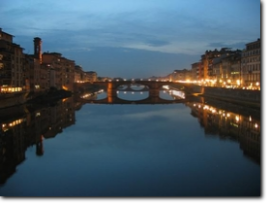
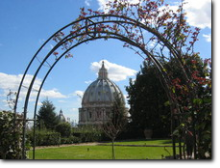
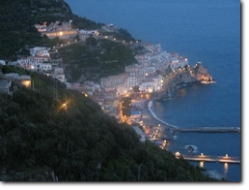
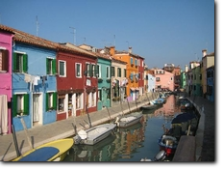
Main menu:
SubTerranean Rome | UnderGround Rome | The City within the City | Rome Travels
Some of the visitors may have been to Rome before and, in this case, have probably seen the Coliseum, the Forum, the Sistine Chapel and St. Peter's Basilica. Well, if so, you have only scratched the surface. There is the magic Rome above the ground that always captivates visitors with its fascinating ruins, colors, fountains, domes and flavors making Rome a veritable a free open theatre.
Then, under the endless vestiges of centuries, there is an underground Rome made up of houses, frescos, spas, baths, villas, condominiums, Insulae, mosaics, stucco decorations, aqueducts, auditoriums, catacombs, colombariums and necropolis. Apparently, they have less appeal than its "major sister", the Rome above the ground but in some cases whose artistic and architectural quality is equal to that of the monuments above the ground.
Us, Rome Travels S.r.l. wish to share this unique heritage from the past with those travelers who want to experience a different way to discover the Eternal City, the Subterranean Rome. If in IInd Cent. A.D. in Rome there were over one million of inhabitants, the underground patrimony embraces the four sides of Rome and even outside of Rome. "Rome was not built in a day": there are multiple layers spread out under the city and so many of them are waiting for you !

In 1956, the pastor of San Pietro in Vincoli, the Roman church that houses Michelangelo's ''Moses,'' decided that the basilica needed a new pavement. So he ordered the old floor taken up, to be replaced by the polished travertine marble found there today.
Before the digging had gone very far, the workmen came upon some ancient remains; and the simple replacement of the floor turned into a complex project of excavation that went on for several years. Like almost every building in the heart of Rome, San Pietro in Vincoli was built over layers of other constructions. Somewhat to his dismay, the pastor found a cross section of Roman history beneath his feet....... continue......read here
Below is not simply a list of the underground archaelogical sites of Rome regularly open to public or upon specific request. We skipped to include all sites as we would need an entire web site. At the same time, we specifically devided the 23 Subterranean sites of Rome per themes to make it easier while turing with us. 1) Sacred Sites 2) Mithraism 3) Water 4) Houses (Domus & Insulae) and public utility 5) Death & The Catacombs of Rome.
1) The Sacred Sites
We incorporated in this section those cultual buildings where not only the Christian adepts but also the Pagans elected to worship their Gods, having religious purposes. In this way, which is the definition and the context of Temples or Sanctuaries or Parish churches in the first centuries of the common era? This was a long and slow path that brought finally to select the Monotheistic Religion (Christianity) versus the Politheistic (Roman and Greek Gods).
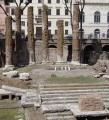
a) Largo Argentina Precint - The area has Four Republican temples, one next to each other going back to the 3rd and 2nd C. B.C. They are the so called A, B, C and D. Easy to remember. Romans were here dedicated to the cult of Feronia (C), Juturna (A), Lares Permarini (D, protectors of the SeaWays) and Good Fortune Today (B, Fortuna Huiusce Diei) whose remains of this Godare visible at the Centrale Montemartini.
Note: this site is unfortunately not available for tours, as it is closed.
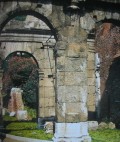
b) The Three Temples of the Forum Olitorium -
As "Forum", there was not existing only the Roman Forum. There were different Forums for commerical use: meat, slaves, fish, olive oil and herbs. These latter ones are the remains in the area corresponding amongst the Capitol Hill, the Marcellus Theatre and the Tiber River. Probably they were the temples of Spes (Hope), Juno Sospita (Juno the Saviour) and Janus. The temple of Juno Sospita was adapted as a the Church of St. Nicolas in Carcere in the high Middle Ages. The crypt under the altar leads to the subterranean section.
Note: this site is unfortunately not available for tours, as it is closed.
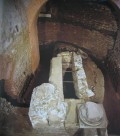
c) Basilica of St. Crisogono -
It is one of the oldest Churches in Trastevere, one of the three Titula in that area. The old church was at one nave only with a portico and an apse and this was planned with two ambients, one surely the sagresty and the other was either the baptistery or a fullonica (laundry and dye-house), or both. The presbitery and nearby the crypt there was a small chapel of the relics. Some of the great fresco walls left are depicting the history of St. Benedict, therefore it is pertinent to restoration carried out by the Pope Gregory III (731-741).
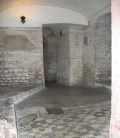
d) The Basilica of S.te Cecilia in Trastevere -
Another Titulus in Trastevere, it is a great example of how many different periods have left traces over the centuries. It goes back from a building of the Republican Age (IInd Cent. B.C.) to the early Church of IVth cent. A.D. It is uncertain if Santa Cecilia suffered her martyrdom right here. The soils are made out of different marble and mosaics; seven round brick basins in the pavement are showing clearly that this ambient was used as a tannery. Pagan images and reliefs are mixed with Christian sargophagi and crosses as a witness of the passage between the Pagan to the Christian Religion.

e) Basilica of St. Clement -
It is the most beautiful, preserved and well accessible tourist attraction of underground Rome. Titulus Clementis, it has plenty of frescoes of Middle Ages in the underground Basilica erected in two phases, then one goes deeper and deeper visiting also the Mithraic Temple and School (3rd level) to the third location of the Roman mint (4th level). In the upper Basilica, there is one of the top 5 mosaics done in the Eternal City, 1124 A.D. This visit is a must.
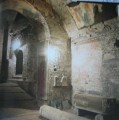
f) Basilica of St. Martino ai Monti - Originally either a market or a condominium (Insulae), it had radical changes when it was transformed into the Titulus Equitii, named after the first titular Church of this man some time around Pope Fabianus (236-250 A.D.). The hall presents a mosaic in black and white with then fresco walls all around.
2) MITHRAISM - The Cult, the Myth, the Meanings and the Rituality.
Originated in Persia several centuries before Christ, its cult spread out in Greece and then in Rome in Ist Cent. B.C. Originally considered as a Solar God and protector of the pacts among tribes, god of oaths in Persia, in ancient Rome gradually assumed a military character with lots of mystical, mysterious and redemptive aspects.
Mythra was born 3 days after the Winter Solstice (December 25th, Natalis Solis) emerging from the solid cave-vault of the heaven in the form of light. The cult of Mythra was performed inside natural or artificial caves and grottoes, being an allusion to the movements of the planets and the cosmos. Thus is explained the apparent contraddiction of worshiping the Solar God and the places of its rituality. Being a pure neo-platonic philosophy, its focus was the journey of the soul through the cosmo, i.e. the seven known planets each one corresponding to a different level of the individual catharsis expressed with different animal sacrifices.
One of the reasons why this great philosophy based upon great moral principles declined was the fact that it was closed to the women versus the Christian Religion.

In Rome, the Temples and the ambients dedicated to the cult of Mythra can be found in the following locations:
1) Basilica of St. Clement - 2) Barberini Palace - 3) Basilica of S.te Prisca - 4) Circus Maximus 5) Baths of Caracalla - 6) Basilica of Santo Stefano Rotondo
3) The Water and the Aqueducts -
In Ancient Rome the Water was often used in order to purify the soul, not only to wash. That is why nearby each Mythraic Temple there was a water source. Anyhow, Rome was also the city of the Acqueducts and the ancient Romans had more water at disposal than today's Romans. In the 3rd Cent. A.D. are censed 12 acqueducts with over a thousands of Thermal Spas (Baths), between the private and the public ones for nearly 1 million of inhabitants.
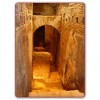
1) Vicus Caprarius -
The archaeological area of Vicus Caprarius also known as the “City of Water” has been recently discovered. Its structures & archaeological area (approximately 400 sq.m/3600 sq.ft) include apartments, a housing block built as a single unit but divided into two buildings extended between the present via di San Vincenzo (the ancient Vicus Caprarius) and via del Lavatore. A step away from the Trevi Fountain, the remains of the Virgin Aqueduct (19 B.C.) are visible on site.
Related Travel Web Site:
Travel and Language Directory - Worldwide Travel sites and Language resources. Hotel, airline, tourism bureaus, State Tourism offices, Language Schools, Dictionaries and more.
4) Houses - Villas - Stadiums
Having an hypotetical time-machine, we can be catapulted in Ancient Rome in any of the normal roads or simply squares with markets, villas, militaries, stadiums. This small section is dedicated to these amusements.
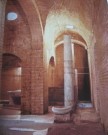
1) The Roman House under the Barracco Museum - Opulence, rich ornaments in fine marble, luxury colums, fresco walls depicting animals and lanscapes brought the archaelogists to think either to a Domus Patritii (Noble House) or, due to the presence of a marble-slab for wieighing and measuring, maybe a simple enclosed market (Emporium) in that area of the Campus Martius (Mars Field).

2) DOMUS AUREA - Nero's Domus Aurea
It was the largest and the most spectacular house ever built in the Roman civilization, thanks to the discussed, crazy and ambiguous Emperor Nero. Fully ornated with the quintessence of the classical beauties, occupied originally 3 of the 7 hills of Rome. On site we can admire its superlative frescoes, great Roman mosaics and huge ambients.
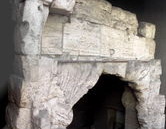
3) Stadium of Domitian (Piazza Navona)
Located exactly just below Piazza Navona, it is where the Emperor Domitian imported in Rome these Greek customs: sports and athletic competition in the Stadium coupled with artistic and literary events in the Theatre located nearby (Odeon). These were the so called "Agon Capitolinus". The Stadium, dating around 96 A.D, could contain rouphly 30.000 spectators.
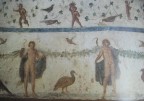
4) The Basilica of Ss. John and Paul and the Roman Houses at the Caelius Hill -
It is the only Basilica in Italy that was erected in the same place where people who suffered their martyrdom (SS. John, Paul, Crispus, Crispinian and Benedicta: Basilica ad Martirium) lived and were executed during the Roman persecutions (363 A.D.). Buildings (Insulae and shops) of 2nd and 3rd Cent. A.D. were incorporated into a bigger one of the 4th with frescos and mosaics and then on top of which was erected the first of the two Basilicas. These ambients of the 4th Cent. were used probably at the same time for the Christian rituality and the Pagan cults, reflecting the spirit of that time and the mix, not confusion, of the religions presence in the Eternal City. It's a wonderful place to visit.
5) Underground Rome: Catacombs of Rome, Necropolis, Colombariums and Mausoleums
The cult of the deaths in Rome was developped since the Etruscan Age (XI Cent. B.C.) mainly in what later became the Valley of The Roman Forum (Archaic Sepulchrums).
A Columbarium is a undeground place for the respectful and usually public storage of cinerary urns (i.e. urns holding a deceased’s cremated remains). The term comes from the Latin Columba (dove) and originally referred to compartmentalized housing for doves and pigeons.
The term Mausoleum derives from the Mausoleum of Maussollos (near modern-day Bodrum in Turkey), the grave of King Mausollos, the Persian satrap of Caria, whose large tomb was one of the Seven Wonders of the Ancient World. The Roman Mausoleums were always above the ground.
The word Catacomb derives from the Greek words Kata-Kymbas (meaning in the by/under the cave/grotto) or the Latin "Ad Catacumbas". They were ancient underground passageways or subterranean cemeteries, made out of narrow tunnels handmade. The first burial galleries to be referred to as catacombs lie beneath the Basilica of St. Sebastian Outside the Walls in Rome (San Sebastiano Fuori Le Mura). The derivation of the word itself is disputed and it remains unclear if it ultimately derives from the cemetery itself or from the locality in which it is found. There is no doubt however that the Catacombs of St. Sebastian are the first to be referred to as such. Today in Rome there have been discovered 57 Christian Catacombs and 6 Jewish ones for a total of 63 Catacombs. This explains a bit how much important were the Catacombs particularly for the understanding of the early centuries of the Christian Religion in the Eternal City.
We needed to make a selection of the too many sites of the underground Rome dealing with the theme of the deaths. We think anyway that our choice is more than enough to spend ... two days!
1) The Pyramid of Gaius Cestius -
Built around 18 and 12 B.C. as a sepulchre for Caio Cestio, a magistrate, representative of the plebeians. Once Caesar Augustus got Egypt on 31 B.C. Romans started to import the cult of the pharaons and there was a veritalbe passion of the Pyramids with several ones. That of Caio Cestio is the only surviving, being attached to the Aurelian Walls. On one face of the pyramid there is an inscription which states that it took 330 days to complete the construction. Thanks to recent restoration work, the interior can now be visited and where one can see the 21 centuries old frescoes paintings.
NOTE: Open only the 2nd and 4th Saturday of each month at 11:00 am.
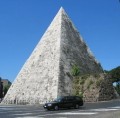
2) The Mausoleum of Cecilia Metella on the Old Appian Way - Erected to honour the daughter of a Roman consul at the end the I Cent. B.C., it is a circular mausoleum based on a square base, similar to that of Caesar Augustus in downtown. Its surrounding areas are some of the best existing in Rome, the Appian Way. In 1303 is was incorporated into the fortified Castle of the Caetani Family of Pope Bonifacius VIII (Castrum Caetani) and became the principal tower of that fortification. Now we can visit the hypogean levels. The Mausoleum and the Medieval Castle offer an interesting view of the construction techniques from the Republic of Rome to the Middle Ages.
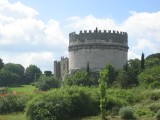
3) The Tombs on Via Latina -
The Archaeological Park of the Tombs of Via Latina, one of the top three funerary complexes of the Rome, still keeps the traditional aspect of the ancient Roman countryside practically intact along the Old Via Latina. In fact, on either side of this ancient road, there are numerous funeral monuments. The funerary monument can be dated to the II cent. A.D. made up of two levels above ground and a subterranean burial chamber. Its status of preservation is impressive. The best ones are the so called Valerii Tomb, dating back 160 A.D. and the Pancratii Tomb. In both tombs we can still admire decorations with mosaics on the floor and stucco & frescoes in the vaults.

4) The Columbarium of Pomponius Hylas -
It is a completely-intact 1st century Roman columbarium, sited near the Porta Latina on the Via Appia on its way out of Rome. It was later bought by Pomponius Hylas for himself and his wife, and he added the mosaic panel over the entrance steps, which is decorated with griffins and reads: CN(aei) POMPONI HYLAE E(t) POMPONIAE CN(aei) L(ibertae) VITALINIS (To Cnaeus Pomponius Hylas and Pomponia Cnaeus the freedwoman of Vitalinus).The inscription also has a V (meaning lived/vivit) over Pomponia's name, showing she was alive when the panel was added. Site of great value.
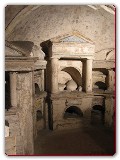
5) THE CATACOMBS OF ROME: In Rome out of 63 Catacombs only 4 are regularly open to the public. For most of the others, we would need a special permit. The catacombs of Rome open to the public are: 1) Catacombs of Priscilla (Via Salaria: the most preserved ones, i.e. beautiful); 2) Catacombs of St. Sebastian (Old Appian Way: the first ones and most important ones for the Christian Religion); 3) Catacombs of St. Callixtus (Old Appian Way, the largest ones with about half million of burial tombs); 4) Catacombs of Domitilla.
As our kind internet visitors may understand, we would need an entire web site made out of hundreds of pages dedicated to the Catacombs of Rome. We suggest the following ones (Official Web Sites): Catacombs of Priscilla - Catacombs of St. Sebastian -
Christian Catacombs of St. Callixtus - Catacombs of Domitilla

6) The Necropolis of S.te Anna and S.te Rosa in the Vatican City State - Built along the Via Triumphalis (the one of the Via Cornelia is where the Apostle Peter was buried, right under the Church), there are hindreds of pagan tombs dating back the Ist cent. A.D. with remarkable stucco works and ornaments, other than mosaics in balc and white proper to the the middle class.
The Vatican Necropolis of S.te Anna and the one of S.te Rosa can be visited thanks to a special permit and exclusively being accompained by an Official Guide of the Vatican City State (us, for example!). It is recommended to visit throuout the visit of the Vatican Gardens. See the section dedicated to the Vatican.
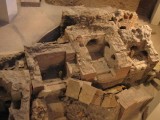
Costs - Guided Tour
Full day Subterranean Rome
Including Private Tour Guide & Transportation (private driver/car-minivan-minibus-bus)
8/10 hours Tour
1-2 people : 1,400.00 EUR
3-7 people : 1,500.00 EUR
8-17 people : 200.00 EUR per person *
18-40 people : 150.00 per person *
* Included the these costs is also the minibus/bus permit & head-sets throughout the tour + lunch, entrance fees are included in the above costs.
Payment: Visa & MasterCard are well accepted.
NOTE: 22% VAT TAX TO BE ADDED IN THE ABOVE COSTS
Costs - Guided Tour
Half day Subterranean Rome
Including Private Tour Guide & Transportation (private driver/car-minivan-minibus-bus)
4/5 hours Tour
1-2 people : 700.00 EUR
3-7 people : 800.00 EUR
8-17 people : 125.00 EUR per person *
18-40 people : 100.00 per person *
* Included the these costs is also the minibus/bus permit & head-sets throughout the tour.
NoteS:
1. Lunch, entrance fees (if any) not included in the above costs.
2. NOTE: 22% VAT TAX TO BE ADDED IN THE ABOVE COSTS
Payment: Visa & MasterCard are well accepted.
Suggested readings:
Carlo Pavia, Guide to Underground Rome, Gangemi Editore
Ivana Della Portella, Subterranean Rome, Arsenale Editrice. You may read the Open Library Here
- Philippe Pergola, Early Christian Rome Catacombs and Basilicas Past and Present, J Paul Getty Museum Pubns


